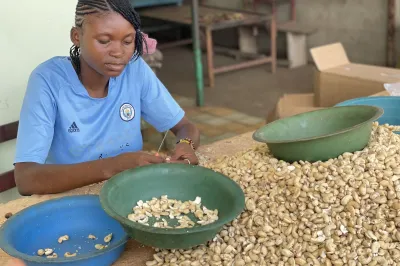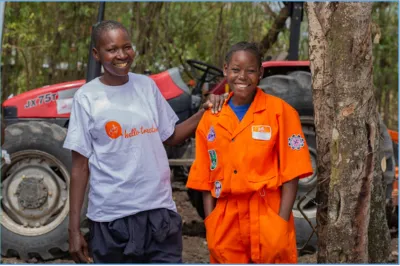Seven Insights From Samunnati on Income Diversification
Sangita* was a sugarcane farmer struggling to make ends meet. Through Kanha Krishi Vanopaj Producer Company Limited, the farmer producer company (FPC) that she is a member of, she gained the training, experience, and support she needed to start a small retail business where she earns a profit of 200 INR (about USD 2.50) a day. Sangita is one of the 80% of economically active women who form the backbone of India's agricultural sector. Women represent 33% of the labor force and 48% of self-employed farmers. Yet, despite their critical role, women's land ownership is a stark contrast, often confined to smaller plots of less than two hectares — illustrating a real impediment in the potential for women's empowerment and income generation from the land.
Sangita’s story represents the kind of income diversification for women smallholder farmers (SHFs) enabled by the solutions and services of Samunnati, India’s largest agri enterprise. Samunnati works through 6,000 farmer producer organizations (FPOs) and farmer producer companies (similar to farmer producer organizations but registered under the Companies Act) on aggregation, market linkages, and advisory services – complemented by customized financing solutions – to reach over 8 million farmers in 28 states, building their resilience to climate change. Recognizing the need to focus specifically on making markets work for women smallholder farmers, Samunnati works to strengthen 53 women-led or dominant farmer producer organizations through improvements in management practices, financial literacy, improved market linkages, and facilitating access to financial services such as credit and insurance. It also encourages increased participation, decision-making, and board representation by women.
CGAP and IDH are collaborating with Samunnati as part of ABERA, Accelerating Business to Empower Rural women in Agriculture, to boost business innovation while driving gender and climate goals. As part of this collaboration, seven insights on income diversification have emerged that other enterprises might benefit from.
1. Women smallholder farmers are not a monolith
Different income diversification options appeal to different women, even if they are all smallholder farmers. It is important to understand the goals, aspirations, and realities of each individual and the household within which they are situated. This makes it possible to evaluate options accordingly and design interventions that are set up for success.
2. Women do not always want to stay in agriculture
In discussing income diversification options with a group of women in rural Tamil Nadu, we learned that some women are keen to provide labor to work at infrastructure-building sites under the Mahatma Gandhi National Rural Employment Guarantee (MNREGA) program. MNREGA guarantees 100 days of wage employment for rural unskilled laborers annually, and the women we spoke to had an appetite for more of this type of work.
3. Home-based income-generating activities are attractive to some
Home-based work opportunities enable women to more easily balance care responsibilities and household chores with running a business. It means that she is home when her children come home from school, or multi-task between home and business-related activities. Sangita runs her shop on the same premises as her home, allowing her to earn an income without compromising on family and home-related obligations.
4. Diversification drives FPC growth
Six women came together at Jaisinagar Soya Samridhi Producer Company Limited to set up a lentil processing plant. This processing plant’s contributions to the farmer producer company’s revenue resulted in turnover growing from INR 5.4 million (about USD 65,000) to INR 30 million (about USD 350,000), which enabled the farmer producer company to provide more services to members. This case also illustrates how farmer producer companies’ assets can be leveraged to grow the incomes of farmers as well as improve business outcomes for the producer companies themselves.
5. Women who demonstrate success in diversifying incomes have become an inspiration to others in their communities
Through her farmer producer company, Ramkumari was made aware of and received training on paper plate making, and then facilitated a loan so she could start producing them. She now earns INR 5,000 (about USD 60) every month, which is encouraging to other women who are looking to diversify their incomes.
6. Income diversification can be an entry point into climate-smart agriculture
Samunnati worked with Bhimpahad Krushak Producer Company Limited to raise awareness of milky mushroom cultivation as a business through information sessions and trainings, including on cultivation and packaging. Milky mushrooms are suited for hot and humid areas, have a longer unrefrigerated shelf life compared to other mushrooms, and require inexpensive infrastructure. Influenced by the potential for economic upside, two women are earning a gross income of INR 300,000/ year (about USD 3,500) and other women in the community are now also looking to cultivate milky mushrooms, kickstarting movement towards the cultivation of a climate-smart crop.
7. Farmer producer companies play an important role in bringing women together to effect change
As women members jointly receive information and training on income diversification, a sense of familiarity and trust emerges. When women within this cohort adopt a new activity and find success, it quickly spreads to other farmer producer company members and can influence them to also adopt new practices (as was previously mentioned). This network effect illustrates women’s groups as a powerful platform to discuss new ideas, exchange experiences, and foster opportunities.
Income diversification for women SHFs is being explored through ABERA’s work as a way to achieve climate-smart, gender-transformative objectives. In our next phase of engagement with Samunnati, we plan to pilot gender-intentional, climate-smart products to uncover insights on how tailored solutions allow women SHFs to expand incomes while building resilience to climate change. While it is too early to say, there may be solutions that also provide income diversification opportunities—stay tuned!
*Editor’s note: name changed to protect identity



Add new comment